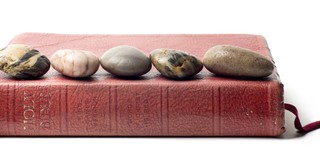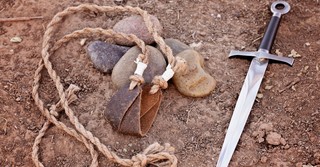10 Significant Ways God Uses Stones in Scripture
Share

Scripture shows God often using common items to accomplish or teach meaningful things. For instance, stones played a part in quite a few special moments the Lord shared with His people. And when a real rock or stone was used, many times it also held symbolic importance as well.
In both the Old and New Testaments, we find accounts of rocks used for several purposes:
- To be markers of significant events
- To indicate a promise or vow
- To represent important tribes or people
- As part of a miracle God would perform
Here are some examples of Bible passages where the Lord used rocks to remind and encourage believers.
1. As a Memorial
“And Joshua set up at Gilgal the twelve stones they had taken out of the Jordan. He said to the Israelites, ‘In the future when your descendants ask their parents, ‘What do these stones mean?’ tell them, ‘Israel crossed the Jordan on dry ground.’ For the Lord your God dried up the Jordan before you until you had crossed over. The Lord your God did to the Jordan what he had done to the Red Sea when he dried it up before us until we had crossed over. He did this so that all the peoples of the earth might know that the hand of the Lord is powerful and so that you might always fear the Lord your God’” (Joshua 4:20-24).
As the Israelites were crossing the Jordan River, Joshua ordered that twelve men representing each tribe take up a stone as they crossed. Those stones were used to build a memorial that would inspire parents to tell their children and grandchildren how God delivered them into the Promised Land.
Today, He will do the same for us, bringing us through every challenge we face.
Photo credit: ©Getty Images/Tizod

2. As a Pledge
“On that day Joshua made a covenant for the people, and there at Shechem he reaffirmed for them decrees and laws. And Joshua recorded these things in the Book of the Law of God. Then he took a large stone and set it up there under the oak near the holy place of the Lord. ‘See!’ he said to all the people. ‘This stone will be a witness against us. It has heard all the words the Lord has said to us. It will be a witness against you if you are untrue to your God’” (Joshua 24:25-27).
Joshua called all Israelite tribes and leaders together so that he could deliver a message from God. They were reminded of God’s protection over them against every enemy they had encountered on their journey from Egypt. Their response was to reject other gods and swear to obey God only.
He is pleased when we take time to reaffirm our commitment to Him.
3. As a Promise
“Early the next morning Jacob took the stone he had placed under his head and set it up as a pillar and poured oil on top of it. He called that place Bethel, though the city used to be called Luz. Then Jacob made a vow, saying, ‘If God will be with me and will watch over me on this journey I am taking and will give me food to eat and clothes to wear so that I return safely to my father’s household, then the Lord will be my God and this stone that I have set up as a pillar will be God’s house, and of all that you give me I will give you a tenth’” (Genesis 28:18-22).
Jacob had been sent from his home to find a wife among relatives living in a distant region. During the first night, he used a stone for a pillow and had a vision of God bestowing blessing on him and his plans as he slept. Jacob was so moved by this that the next day he used that stone as a pillar where he committed himself to God.
God desires to guide us and to bless our way forward.
Photo credit: Pixabay/Pete Linforth

4. As a Vessel of Provision
“’I will stand there before you by the rock at Horeb. Strike the rock, and water will come out of it for the people to drink.’ So Moses did this in the sight of the elders of Israel” (Exodus 17:6).
During the Israelites’ journey to the Promised Land, they reached a place that had no water. They grumbled to Moses, who turned to God. Then, in front of all the people, the Lord showed them another miracle, by bringing water out of a rock.
He is always faithful to provide just what we need, sometimes in ways we don’t expect.
5. As Recognition of Israel’s Tribes
"'Take two onyx stones and engrave on them the names of the sons of Israel in the order of their birth — six names on one stone and the remaining six on the other. Engrave the names of the sons of Israel on the two stones the way a gem cutter engraves a seal. Then mount the stones in gold filigree settings and fasten them on the shoulder pieces of the ephod as memorial stones for the sons of Israel. Aaron is to bear the names on his shoulders as a memorial before the Lord. … ‘Fashion a breastpiece for making decisions — the work of skilled hands. … Then mount four rows of precious stones on it. The first row shall be carnelian, chrysolite and beryl; the second row shall be turquoise, lapis lazuli and emerald; the third row shall be jacinth, agate and amethyst; the fourth row shall be topaz, onyx and jasper. Mount them in gold filigree settings. There are to be twelve stones, one for each of the names of the sons of Israel, each engraved like a seal with the name of one of the twelve tribes’” (Exodus 28:9-12,15,17-21).
God told Moses to build a tabernacle where His people would worship and bring offerings. He decreed every detail, from the construction to the adornments He wanted inside. Among the splendors, God commanded that precious stones be used to represent the tribes that made up Israel. These were to be sewn into the garments worn by the priest, to signify His relationship with them.
He calls us to show we are His by holding ourselves to His standard.
Photo credit: ©Sparrowstock

6. As a Show of God’s Strength
“As the Philistine moved closer to attack him, David ran quickly toward the battle line to meet him. Reaching into his bag and taking out a stone, he slung it and struck the Philistine on the forehead. The stone sank into his forehead, and he fell facedown on the ground. So David triumphed over the Philistine with a sling and a stone…” (1 Samuel 17:48-50).
As a young man, David had already had an anointing from God. So when David found himself with the Israelite army and heard Goliath’s challenge, he was granted courage and wisdom. And through David, God used something as small as a stone to accomplish a major victory for His nation.
In His hands, the smallest prayer we say or act we do becomes great.
7. As a Bold Act of Worship
“Elijah took twelve stones, one for each of the tribes descended from Jacob, to whom the word of the Lord had come, saying, ‘Your name shall be Israel.’ With the stones he built an altar in the name of the Lord, and he dug a trench around it large enough to hold two seahs of seed. He arranged the wood, cut the bull into pieces and laid it on the wood” (1 Kings 18:31-33).
The prophet Elijah issued a challenge to Arab, one of the most wicked rulers of Israel, and the over eight hundred false prophets. At Mount Carmel, Elijah constructed an altar where God demonstrated His power, sending down fire to destroy the offering, the wood and the stones. The people were awestruck, and recommitted themselves to the Lord in that moment.
Our mighty God always works on our behalf.
Photo credit: ©Getty Images/pamela_d_mcadams

8. As a Test
“Then Jesus was led by the Spirit into the wilderness to be tempted by the devil. After fasting forty days and forty nights, he was hungry. The tempter came to him and said, ‘If you are the Son of God, tell these stones to become bread’” (Matthew 4:1-3).
The same enemy that tempted Eve to sin in the Garden of Eden was now trying to tempt the Son of God in the desert. Satan’s first angle was to appeal to Jesus’ very real physical need, and then to coax Him to use His power to make mere stones into food. Jesus defeated the enemy, quoting His Father’s own words.
God wants us to speak His Word out loud as a way to stand firm in our faith.
9. As a Reminder That God Is Our Foundation
“Therefore everyone who hears these words of mine and puts them into practice is like a wise man who built his house on the rock. The rain came down, the streams rose, and the winds blew and beat against that house; yet it did not fall, because it had its foundation on the rock” (Matthew 7:24-25).
In His Sermon on the Mount, Jesus taught on many topics, with the aim of explaining what it means to be righteous. He added that those who want to live this way need to be grounded in God, learning His Ways and giving Him worship.
He is the firm bedrock that will hold us up and support us.
Photo credit: ©Getty Images/Christoph Auer

10. As an Image of God’s Plan for His People
“As you come to him, the living Stone — rejected by humans but chosen by God and precious to him — you also, like living stones, are being built into a spiritual house to be a holy priesthood, offering spiritual sacrifices acceptable to God through Jesus Christ. For in Scripture it says:
‘See, I lay a stone in Zion,
a chosen and precious cornerstone,
and the one who trusts in him
will never be put to shame.’Now to you who believe, this stone is precious. But to those who do not believe, ‘The stone the builders rejected has become the cornerstone…’” (1 Peter 2:4-7).
The Apostle Peter echoed Psalm 118 here, using the image of a stone to describe both Jesus and His followers. As the cornerstone of a building serves as its foundation, Peter called Christ the cornerstone of the church. He then urged believers, as “living stones,” to join together in unity to glorify God.
Our Lord calls us to be in community, sharing the work and the joy of serving Him.
Father in Heaven,
I give thanks for all Your creation, and how You use the smallest of things in it, even rocks or stones, to help us grow in our faith. Give me wisdom to take in the insights You reveal in Your Word.
In Jesus’ Name,
Amen.
Photo credit: ©Getty Images/Yevheniia Bondarieva
